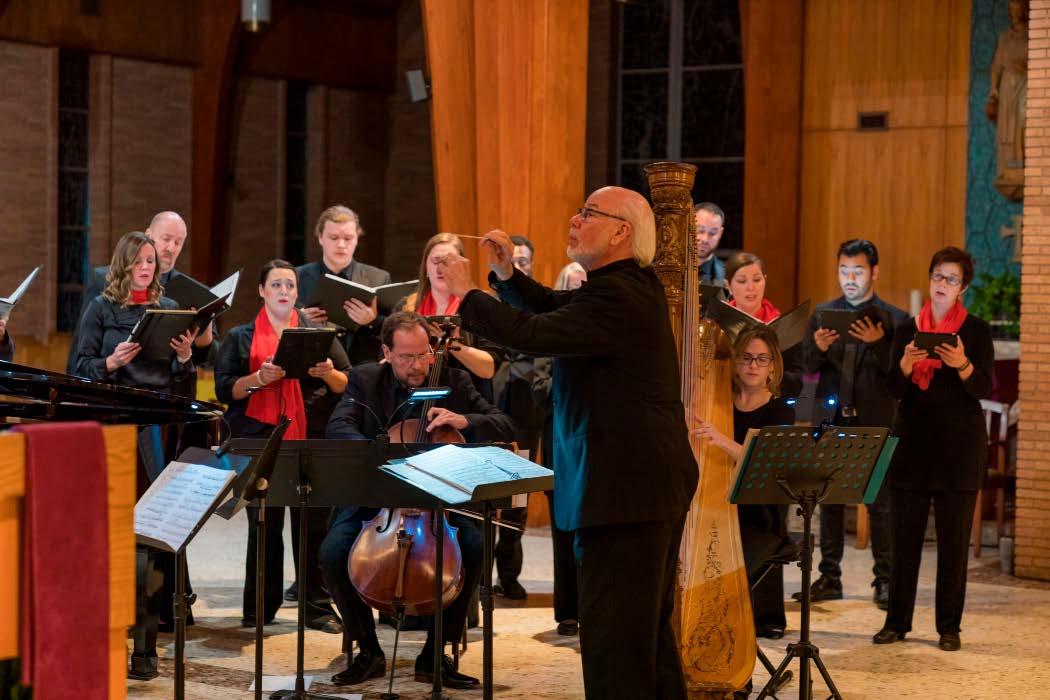
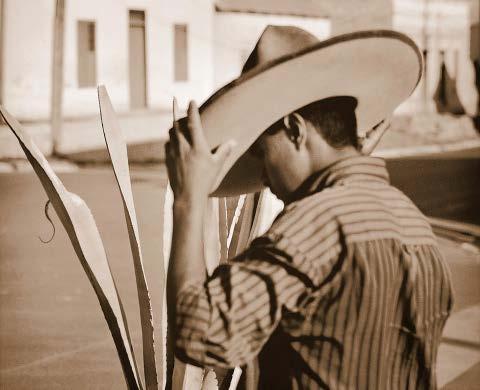



This grass roots publication is the life source for a community that is not easily afforded viable access to diverse and ac cessible media. San Antonio and the sur rounding counties have become accustomed to relevant news brought to them in both English and Spanish since 1913.
Yvette Tello
Interim Publisher y.tello@laprensatexas.com
Ramon Chapa Jr. Community Liaison r.chapa@laprensatexas.com
Roxanne Eguia Editor In Chief r.eguia@laprensatexas.com
Nicodemus Gonzalez Graphic Designer Dr. Ricardo Romo Contributors info@laprensatexas.com José I. Franco Editor Español Maria Cisneros Sales Representative Roy Aguillon Digital Editor
Adeymius Vasquez Editor Melissa Bryant Publishing Assistant
La Prensa Texas, Inc., is a Texas nonprofit Corporation. We are under new man agement and not affiliated with La Prensa Foundation, Inc.; La Prensa Publications, Inc.; La Familia Duran;Duran Duran Inc.; or any of the Tino Duran family companies. We are not responsible for, nor will we be liable for the acts, omissions or debts of La Prensa Foundation, Inc.; La Prensa Publica tions, Inc.; or any of the Tino Duran family companies.
La Prensa Texas San Antonio is published once a week by La Prensa Texas Inc. San Antonio, Texas (210) 686-0600. Subscription price in the U.S.A. $125 per year (52 issues). The opinions expressed in the editorials of this publication represent the positions and ideology of this newspaper; the opinions expressed by writers and guest columnists are not necessarily the opinions of the management staff or ownership of this newspaper; the contents of which they are solely and exclusively responsible for. Letters from our readers are welcome and will be published, subject to space availability so long as they are signed and have a proper return address. All letters will be reviewed and edited for offensive language, libel, slander, defamation, proper grammar, spelling, and accuracy, according to our style. La Prensa Texas Inc. is not responsible for advertisements that may be deceitful or fraudulent, and does not guarantee in any way the products or services of fered, of which only the advertiser is responsible. All Rights Reserved. Published and printed in the United States of America.
Racism is where someone thinks you’re inferior because of your color, ethnicity, national ity or race. This can result in them treating you differently or unfairly, this is called racial discrimination.If someone makes racist comments against you, do you get offended or do you ignore it? If you ignore it, is it weakness or resilience? What is the worst racist thing you have experienced? Let's talk about it... #letstalkaboutit
Frances Potter: ”The United States is composed of immi grants. I am very proud of hav ing both cultures, and have trav eled some to learn about others! God bless the ones that think they are better than others. Only God is bigger and better and he made us all. It's hard to educate stupid! Ignore it and move on. It's not worth it!”
Manuel C Ortiz: “Dealt with many forms, just handle each different.”
Michelle Morris: “I have never faced racism in my life until we got stationed in NC. When we arrived we were starved and went to a local mom and pop restaurant where they stared and ignored us and my ex just said let’s go. I figured they were just busy. I went to camp Lejeune using what’s called 9 mile road and saw signs that
read.. “ if you’re a N or a spic don’t let the sun shine down on you.” Again, didn’t know what that meant and my ex said not to worry about it and to not use that road again. Lastly, we were moving into base housing where we heard.. “ damn beaners are moving in.” I asked my ex and he sat me down and said that we are Mexicans and that I would probably hear and see a lot of racism but to ignore it. I remem ber crying and begging my ex to go back home. Through our tour there, I got stronger and chose to ignore ignorance. I still choose to ignore it. Please don’t get me wrong NC wasn’t all bad but that’s where I first encountered racism. I was brought up in a very strict Christian home and was raised to forgive others as they know not.”
Charles Mario Henry: “Where I’m from, we don’t let that ride. We check it right away. To ignore is too close to ignorance. Racism is something my people fought and died for TO THIS DAY. I will not let anyone disrespect my race or culture by ignoring the hate because it doesn’t teach any les son. They can pray to God for forgiveness and healing of their racist mind after I check their ignorance.”
Carmen Madrigar: “Pray for their souls! My skin is brown and I don't frown! I'm glad to be who I AM you see! Our blood
runs rich with Amor and cour age! My Chicana you can not discourage. Accept from the EYE OF THE EAGLE...cdela Madariaga.”
Ramon Chapa Jr: “I ignore it! I am a U.S. Army Veteran and proud to be Mexican AMERICAN, Christian, College Educated and Good Looking! I really don't care what anybody says! It is a major strength to know, "What to Ignore"! Jesus was the most criticized person to ever live. You know what he did, He Ignored It!”
Lydia Curran: “I don't ever remember anyone ever saying anything like that to me, at least not to my face. But I would just laugh at them & walk away. Enough said.”
Do Nana: “When you forgive without demanding justice, you reward injustice.”
Adeymius: “There are many factors I look at, but most often I don't take it to heart. People are different and some are more open minded than others. If I let it bother me, then I have not moved on with being better with my way of thinking. It's a pro cess to use critical thinking and learning to be better with communication in society.”
Denise Rodriguez: “The best way to fight oppressive, alien culture is to live your own.”
Joel Salcido grew along the U.S. and Mexican border.
As a staff photographer for the El Paso Times he documented the Tarahumara Indians and covered the 1985 Mexico earthquake. He also traveled extensively in Latin America for
USA Today.
In 1991 he resigned as Photo Editor of the El Paso Times eventually moving to Spain to work on a year long project titled, Spain: Mil lennium Past.
His fine art photographs are now in the permanent collections of the Museum of Fine
Arts, Houston, the prestigious Harry Ransom Humani ties Center at UT Austin, The El Paso Museum of Art, The Austonian and The Wittliff Collections at Texas State Uni versity-San Marcos and the UTSA Art Collection. In 2017 Trinity University Press
published his book, The Spirit of Tequila, based on his series, Aliento A Tequila, a photographic exhibit that is now on a national tour. The emblematic landscape photograph from the Te quila series titled, “Atotonilco el Alto,” was recently induct
ed into the National Art Heritage Collection of Mexico and permanently resides at the Ministry of Foreign Affairs in Mexico City.
In 2021 Salcido was a guest artist representing San Antonio at the Jorna da Binacional Para Artistas in Mexico City.





Instructor Trinidad Gonzales has made history himself by becoming only the second recipient of the John Lewis Award for History and Social Justice.
The award was established in 2021, named in memory of the late State House of Representative for Georgia’s Fifth Congressio nal District and one of the most renown leaders of the civil rights movement John Lewis, who died in 2020, and recognizes historians for leadership and sustained en gagement in historical work.
Gonzales said when he first learned about receiving this award, he was stunned.
“I was in complete shock, speechless,” said Gonzales. “I didn’t know what to do, so I called my wife, in a panic because I couldn’t form the words to tell her what had just happened. I never expected anything like this.”
Nominations for the award are submitted by individuals or col laborative groups that highlight the works of professional historians whose accomplishments exempli fy the value not only of historical work, but also public culture and social justice.
In the words of the late political icon, “Everyone must study and learn the lessons of history because humanity has been involved in this soul-wrenching, existential struggle for a very long time.”
Gonzales said he doesn’t know who nominated him, but he is grateful to whomever did.
“I’m still processing it all, but this is a great honor,” he said. “And I’m thankful for this unique op portunity. This isn’t an award for only me though, it’s an award for everyone who does this work…it represents a large group of people, a coalition. It also highlights the type of faculty we have at STC and the great work they are doing.”
Gonzales takes his passion for inclusive and accurate history into his classroom, where he sets aside time specifically to focus on Lower Rio Grande Valley history.
A part of Gonzales’ work has been advocating for inclusiveness and educational equality; publish ing op-eds and articles in an effort to undo the legacy of racism, es pecially for the Mexican American culture; working with legislature regarding how Mexican American history is taught in the classrooms and most recently was involved in the five-year fight to get state standards for high school Mexican American history classes.
As part of the five-year fight, Gonzales helped to reject a pro posed racist textbook of Mexicans and Mexican Americans, working with about 15 other scholars. He led the way in assessing the book for factual errors. The group testi fied against the textbook in front of the Texas Board of Education.
Gonzales has also been recog nized with national awards for his efforts, including the Herbert Feis
Award for Public History from the American Historical Associa tion for his work with Refusing to Forget (RTF), a nonprofit that tells the history of state-sanctioned killings of Mexicans and Mexican Americans during the 1910s; and the Friends of History Award in 2021 from the Organization of American Historians also for his work with Refusing to Forget and for his outstanding support for historical research and public presentation of American history.
“As a historian, my job is to teach the truths of history, to il luminate an understanding of the issues,” he said. “Historians - we help policy makers understand and work to remove the silencing of history that sometimes occurs
in curriculums. We are a group of people who represent and ad vocate…no one alone can make social changes.”
In January 2023, Gonzales will travel to Philadelphia to accept his John Lewis Award for History and Social Justice at the American Historical Association national conference, where he will also present on his advocacy, cultural and social justice efforts.
Founded in 1993, South Tex as College is accredited by the Commission on Colleges of the Southern Association of Colleges and Schools and offers more than 127 degree & certificate options, including associate degrees in a variety of liberal art, social sci
ence, business, math, science, tech nology, advanced manufacturing and allied health fields of study. Additionally, South Texas College is the only community college in the state of Texas to offer five bac calaureate degrees. South Texas College has a faculty and staff of more than 2,700 to serve 28,000 students, on the college’s six campuses, two higher education centers, and one virtual campus.
Photo Caption: South Texas College History and Mexican American Studies Instructor Trini dad Gonzales has made history himself by becoming only the sec ond recipient of the John Lewis Award for History and Social Justice.

El popular chef Víc tor Hugo Silva apodado "Taquitos al Minuto", por su 54o cumpleaños y su hijo Jr. (Víctor Hugo Silva, apodado "Perro"), quién cumplió 27 años fueron festeja dos en grande por su esposa. Sra. Nora Silva, su hija Brenda Harrell y su yerno "El Cowboy" Aubrey Harrell, quiénes en su elegante residen cia ofrecieron excelente ambiente familiar.
Donde en repetidas veces brindaron por el doble cumpleaños y el feriado de la tradicional cena del Thanksgiving Day.
Con lo qué dieron gracias al Creador Divi no por todas las bendi ciones qué han recibido durante el año.
Víctor y su esposa Nora, son dueños de
Taquitos al Minuto, por lo qué por éste con ducto dan las gracias a su clientela qué por años han preferido sus valiosos servicios en la preparación de su diverso menú servido en Eventos especiales, sociales y deportivos en nuestra próspera región de San Antonio.
"Estamos satisfechos porqué sé nos hizo re alidad celebrar nuestros cumpleaños. Doy gra cias a mis hijas; Joanna, Judith. Janet y Fátima. Así cómo sus respectivas familias quiénes nos acompañaron y nos

desearon parabienes", dijo Víctor Sr.
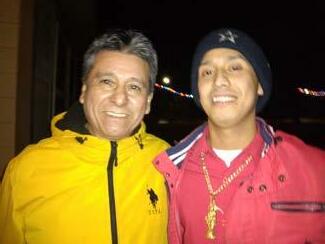
Pará culminar la magna doble cele bración, ambos fes tejados, ya entrada la media noche tuvieron sorpresiva visita de una bailarina exótica.
Lo cuál fue de su ex celente agradó y del buen gusto de invitados y familiares. Por ello fue qué Mister Silva y Perro, la pasaron de maravillas durante su inolvidable doble fes tejó en el qué padre e hijo la pasaron bastante divertidos. (Foto de Franco).
Por Franco
El honorable señor Mario Alberto López Gámez (Mayito), presidente municipal de Nueva Rosita, Coahuila, hizo viaje exprofeso a San Antonio, Texas tras haber sido distinguido como Padrino por el comité organizador del tradicional torneo abierto Thanksgiving Day 2022 qué preside El Rielero Mayor Juan Sánchez y es apoyado por el artista Eloy Rocha dueño del complejo deportivo Potranco Baseball Field y Simón Sánchez presidente de la Liga Potranco. [Sede del cuadrangular].
Mayito López, de 30 años de edad quién fue electo pará la gestión de 2022-2024 repre sentando al partido MORENA, acompañado por su suegro Leo Saucedo, durante su presencia en el estadio Potranco fue abordado (antes y después de tirar la primera bola), por los aficionados qué en su mayoría son de origen del municipio qué el preside.
Su popularidad es magna ya qué La Prensa Texas, sé dio a la tarea de escuchar las buenas propuestas y deseos qué sus paisanos le desearon. Su carisma político ha sido la base pará salir adelante en sus promesas de candidato y cómo
alcalde ya qué sus paisanos residentes en San Antonio han visto los cambios que en su cortó tiempo cómo presidente municipal ha logrado todo en beneficio de su gente.
Durante la ceremonia del primer lanzamiento Mayito López tuvo en la receptoría a Chuy Car mona (copatrocinador del torneo), Juan Sánchez de ampayer quién cantó el primer estraique y Leo Saucedo, (su suegro), al bate.
"Bien agradecido con Juan Sánchez, nos dio emotivo recibimiento, por lo qué agradezco y los buenos deseos de los paisanos aficionados. Doy gracias a Dios y mí familia por el apoyó
qué me han dado en todos los aspectos", dijo Mayito López.
Cabe anotar qué una de sus promesas de campaña, fue el regreso del club de béisbol Mineros de Nueva Rosita, al circuito Liga del Norte de Coahuila. Lo cuál así fue ya qué él lo adquirió cómo ciudadano privado. Y en está su primer temporada logró ganar el campeonato tras derrotar al potente rival Bravos de Sabinas. Mayito López, continuará su gestión, con Integridad personal, ya qué fuera del béisbol. Destacó qué sus gastos son de su propia cuenta bancaria. Tanto en vehículos de su flotilla de


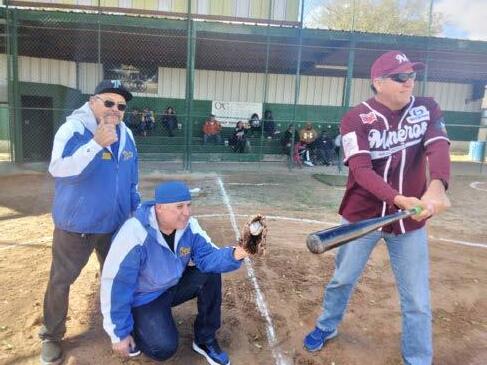
trasporte cómo viajes a la capital de México y el exterior. Por lo qué sé le algura tendrá una brillante trayectoria en la arena política. En las fotos aparecen: Mayito López tirando la primera bola. El catcher Chuy Carmona, el bateador Leo Saucedo y el ampayer Juan Sánchez. Pre sentación de placa de recocimientp y el popular tamborero beisbolista Juan Ramón Ramírez "La Mila", tío del popular beisbolista internacional Morris Ramírez (quién jugó con Mineros en el campeonato ganado 2022 y jugó para Tuzos SA en éste torneo), la mascota El Chango de Sabinas. Coahuila (Fotos de Franco).













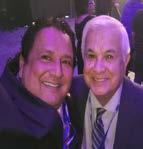





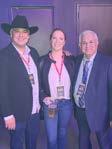



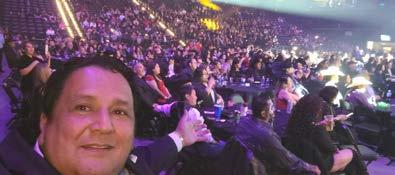
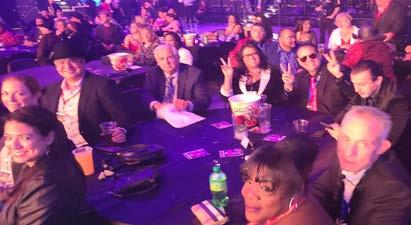 By Ramon Chapa. Jr.
By Ramon Chapa. Jr.
Thank You to Tejano Mu sic Awards/TTMA Presi dent Robert Arellano for the V.I.P. treatment to La Prensa Texas and Commu nity Liaison Ramon Chapa Jr at the 42nd Annual Tejano Music Awards held at the Tech Port Center + Arena in San Antonio, Texas. Event was hosted by Comedian Happy “The Entertainer”. Live Performances were by Jay Perez, Shelly Lares, Isa bel Marie, Sunny Sauceda, Stefani Montiel, Ricardo Castillon y La Diferenzia, The Homeboyz, Eddie Gon zalez, Monica Saldivar, Da Krazy Pimpz, and Proyek to Kumbia “Los Original Kings”. Lifetime Achieve ment Awards were presented to “Music Producer” Gilbert Velasquez & “Founder of The Hometown Boys” Ro man Martinez. The pictures tell the story!
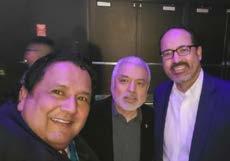

Map
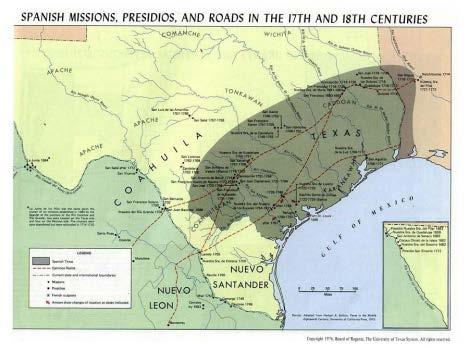 By Dr. Ricardo Romo
By Dr. Ricardo Romo
Texas, with its size, diverse geography, politics, and cul ture is many things to different people. The New York Times deputy political editor Manny Fernandez posed a series of questions recently that reveal the complexity of the Lone Star State. He wrote “Who are these people, these Texans? What do they tell us about America? What to make of a state that is so focused on itself? I wrestle with these questions all the time.” I decided to briefly explore some of these questions by focusing on one region–South Texas. What I found was revealing to me as an historian, and I learned of a previously unknown personal connection to the rich history of South Texas.
South Texas is a region where history is valued and where the area’s past has special meaning to the rest of the state. The num ber of books written about Texas surpasses that of the majority of states. Nonetheless, scholars recognize that glaring gaps exist in history related to ethnicity and diversity in regions such as South Texas. My inter est in these topics, as well as in these historical gaps, led me to explore how my family came to Texas in the mid 1700s. I was curious about the contribution of the pioneering families who settled South Texas along the Rio Grande 273 years ago and if they left a meaningful historical footprint.
South Texas, the region where my ancestors first settled, is one of the seven distinct regions of Texas. Although not the largest of the seven regions, South Texas has the oldest nonIndigeneous settlements of the state. Spanish settlers established South Texas towns, including San Antonio, which was founded in 1718, and numerous border towns along the Rio Grande dat ing back to 1749. Compared to the other regions of Texas, South
Texas is logically the principal cradle of Texas history.
The origins of South Texas as a region–its towns, its ranching industry, its agricultural prow ess–has always fascinated me.
The intrepid Spanish colonizer José de Escandon played a ma jor role in South Texas history.
Historian David Weber noted that in planning to settle a new territory along the Rio Grande in 1749, Spain, for the first time, relied on colonists rather than missionaries. The Spanish Crown appointed Escandon as the colonizer and first governor of the colony of Nuevo Santander. The area extended from the Panuco River near Tampico in Northern Mex ico to the Guadalupe River in Central Texas.
Escandon established over twenty towns or villas and a number of missions in the Nuevo Santander colony. Among the
towns he founded were Camar go, Reynosa, Mier, and Revilla, south of the Rio Grande, and Laredo and Dolores north of the Rio Grande. Escandon had Span ish Royal authority to issue land grants to settlers, mobilizing the colonization of South Texas from the Rio Grande to the San Antonio River. To put this early colonization into perspective, Stephen F. Austin brought only 300 families to Texas. Escan don led 6,000 Spanish settlers, mostly mestizos, to South Texas and the Rio Grande region.
My ancestors, descendants of my great-grandfather Capt. Miguel Sanchez Sáenz [10th generation], came with Escan don to Mier, then crossed the Rio Grande and founded five individual ranches in what would later be known as the pueblo of Roma-Los Sáenz. The ranches included Porciones #72 to Juan Angel Sáenz #73 to José Miguel
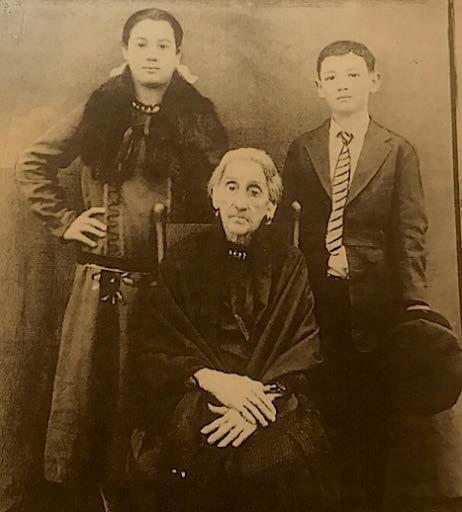
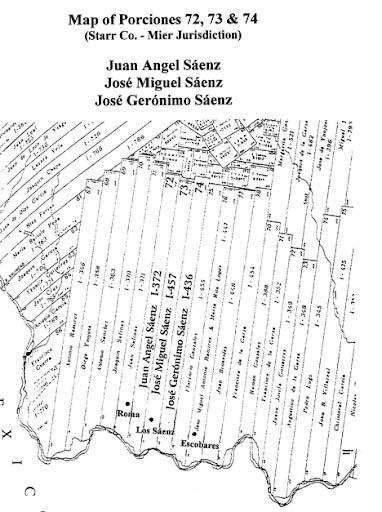
Sáenz, and #74 to José Geronimo Sáenz. Each porcion could be as large as 20,000 acres. Two first cousins José M. Sáenz de Hinojosa and Juan F. Sáenz de Hinojosa established adjacent ranches, La Bonita Ranch and Las Flores Ranch. The combined Sáenz grants likely exceeded 60,000 acres.
Historian Andres Tijerina, author of Tejano Empire: Life on the South Texas Ranchos, wrote that as a result of Escandon, in less than 50 years the Tejanjo ranches accounted for 85,000 cattle, horses, and mules. From 1757 when the early Spaniards established ranching along the Rio Grande to 1795, the live stock increased to approximately 800,000, including 111,777
cattle. Tijerina documented that by 1800, “The Cattle King dom included over five million longhorn cattle that the Tejano ranchers and their ancestors had brought into South Texas.”
Cattle ranching had its origins in South Texas and is considered Texas’ first industry. Although Spaniards introduced cattle and horses to Texas in the 1690s, Tejano historians note that it was not until the 1750s with the arrival of the 6,000 Spanish colo nists who settled dozens of Rio Grande land grants that major cattle raising began to thrive. Un til recently I never knew that my family had a connection to the start of Texas ranching society.
Over the period 1750-1850, South Texas became the leading
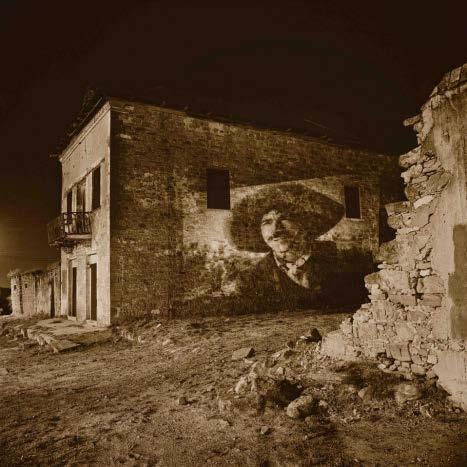
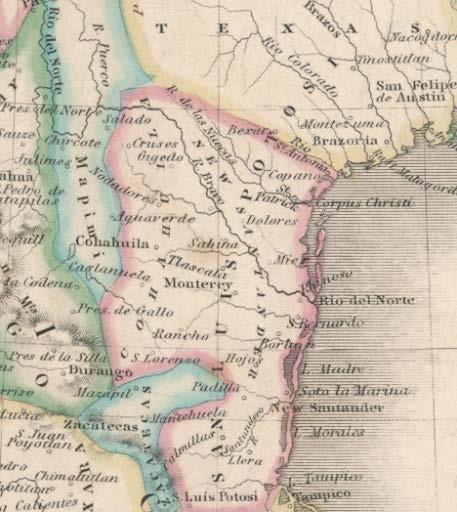
ranching region of the United States. However, in the post 1800 era, the region experienced a series of major wars that took a toll on the residents and their livelihood. When French forces under Napo leon conquered Spain, the Span ish colonists in Northern Mexico took up arms. In 1813, Spanish Royal armies invaded South Texas with an aim to suppress the Tejano colonists who had organized to liberate themselves from Spanish-French colonial rule. The Spanish Royalist sol diers defeated the Tejanjo rebels in the Battle of Medina River near San Antonio, the bloodiest battle in Texas history. Next came the Texas Revolu tion of 1836 that originated in Gonzales, Texas and moved quickly to the Alamo in San Antonio. The battle over Texas took less than a year and resulted in Mexi co's unofficial loss of Texas. Mexico’s Congress refused to acknowledge the loss of Texas. Next came the Mexican War of 1846-48 in which the American forces’ victory over Mexico re sulted in Mexico ceding author ity of five of its Northern frontier states. These three wars changed South Texas forever. After these bloody conflicts, some South Texas ranching families fled to Mexico or lost their land through dubious legal challenges.
The American Civil War which broke out in 1860, brought illegal land grabbers and individ uals who profited by trading with both Yankees and Confederates in cattle, horses, and cotton. Roma, with its high bluffs and deep waters of the Rio Grande, served as a major port for ships carrying contraband goods to Southern and Northern ports.
The combination of land ac quisition and Civil War con traband in South Texas often promoted great wealth. Charles Stillman, for example, acquired land from the Garza grant, origi nally the Cavazos ranch consist ing of 600,000 acres, and at the time, the largest ranch in Texas. Historian John M. Hart noted that the sellers “had no legal right to make such a sale since their father had remarried and the heirs of his second wife inherited the land from their father upon his death.” According to Hart, Charles Still man also bought cotton during the Civil War and sold it in New York. By the end of the war Still man was one of the richest men in America.
To many observers, South Texas had more than its share of turmoil and political change. My great-grandmother, Marta Pompa de Sáenz, a resident of South Texas from 1834-1939, lived under five different na tional flags during her lifetime–Mexico, the Republic of Texas, the United States, the Confed eracy, and finally again, the United States. Her son, and my grandfather Jose Maria Sáenz, a
landless vaquero, worked cattle and horses in the Brush Country of South Texas. He left ranch life in 1901 to live and work in San Antonio.
With the filming of the movie Viva Zapata in 1951-52, the small town of Roma achieved brief Hollywood fame. The movie, starring Marlon Brando, Jean Peters, and Anthony Quinn, earned an Academy Award for Quinn. Quinn was the first La tino to win such a distinction. The film director, Elia Kazan became familiar with Agustin Casasola, the famed Mexican photographer of the Mexican Revolution. Kazan sought a lo cation that resembled Mexico of the 1910-1920 era, and in Roma they found the perfect setting.
Today, Roma, known to local residents as Roma-Los Sáenz, is a vibrant border town with a population of 11,505. Ranching is still important, but oil wells contribute significantly to the re gion's economic stability. Roma maintains its bilingual–bicultural culture evidenced by the recent mariachi state championship won by the Roma high school band.
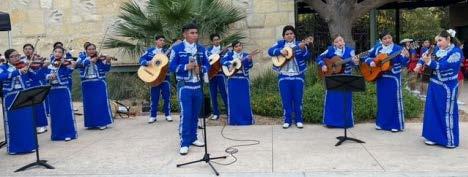








Por Sendero Deportivo Espectacular fin de semana disfrutaron fanáticos del gran béisbol regional categoría Abi erta en los Campos 1 y 2 del es tadio Potranco, durante el con currido torneo Thanksgiving Day 2022 organizado por Juan Sánchez (El Rielero Mayor), quién una vez más agradeció el apoyó de Eloy Rocha dueño del parque Potranco y de Simón Sánchez presidente de Liga Potranco.
Los equipos participantes fueron el visitante Los Va
queros de Austin campeón del torneo Thanksgiving Day 2021, dirigidos por Hugo Franco y el coach Wenceslao Ruiz (dueño).


Agujita del manager Juan Pedro Reza y su sobrino Brayan Guerrero [coach qué armó el cuadro].
Tuzos de San Antonio, man ager Checo Saldaña y el legend ario Rodrigo (Lolo) Rodríguez de coach. Los Cerveceros de Nacho García. Coach Eleazar Pérez (ex ligamayor)
La ceremonia de apertura comenzó con el primer lanza
miento efectuado por Mayito López presidente municipal de Nueva Rosita, Coahuila quién recibió placa de reconocimiento por su trayectoria en beneficio del deporte y la comunidad qué él representa cómo alcalde por el partido MORENA.
Resultados de la primera jor nada. Campo 2. Los Vaqueros de Austin doblegaron a Los Cerveceros con pizarra de 2-1. Campo 1 Agujita derrotó 9-5 a Tuzos SA.
Por el tercer lugar Tuzos der rotó a Cerveceros con pizarra de
5-4. Por el trofeo de campeón Los Vaqueros de Austin de cierre defendió su banderín derrotando en gran partido al también trabuco de Agujita con score de 5-4 carreras.
"Segundo campeonato con secutivo qué llevamos pará Austin", dijo Hugo Franco. "Enfrentamos a un buen rival", indicó JP Reza. Juan Sánchez, Eloy Rocha y don Simón Sán chez, felicitaron a los equipos y agradecieron el apoyó de los espectadores, procediendo a la entrega de trofeos.
Güero Villanueva de Tuzos, recibió trofeo del cuarto lugar. Nacho García, tercer lugar. JP Reza subcampeón. Hugo Franco y Wenceslao Ruiz el de Bicampeón y Onel Vega, primera base de Austin el de MVP por bateo de 8-4 en el torneo. Todos ellos aparecen en la fotografía superior. En la imagen inferior Los Vaqueros, qué recibieron felicitaciones de su base de seguidores y direc tivos del Torneo Thanksgiving Day 2022. (Fotos de Franco).
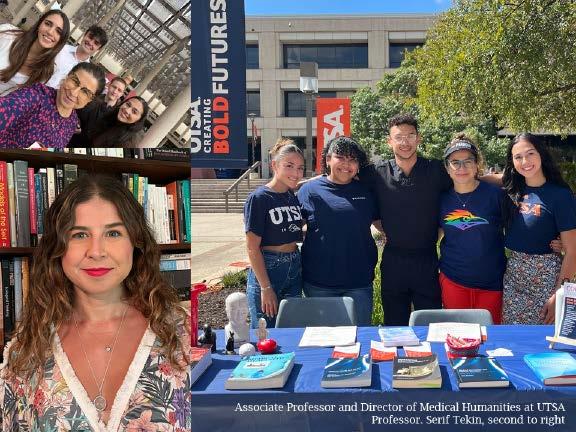
There comes a time or mo ment that our connection with another human being is of the utmost importance and technol ogy can’t help us, only good old-fashioned communication. Now whether it’s good or bad is dependent on our actions towards each other and other circumstances. But how do we make sure we communicate effectively, why does it matter, and why is a medical course important for everyone? And why do I need it?
In an interview with Profes sor Serif Tekin of UTSA, who is also the Associate Professor; Director of Medical Humani ties, she explains that while it is important for students to take this class for medical studies there is much more to it than just academics. It’s the use of Phi losophy to engage with science towards not only oneself but the mind and ethics. The aim is to educate students in healthcare professions on the experience of illness, health, and stability from a more humanistic perspec tive, to understand the human in their experience and avoid the pitfall of being distant, cold, or perceived as not understanding.
She describes her classroom and programs as engaging and useful for preparing students to become better healthcare providers while learning the history of medicine and about health today to compare with the past and to make better judg
ments. During her discussion, she talked about cancer and what does it really mean? And how do issues such as these affect the interplay of the dimensions of a person’s life? What about mental health, and homeless ness? And why it’s crucial to understand the inner workings of the emotions attached to something like that for a human being. Philosophy is her passion and with Cognitive Science and training as a scientist in econom ics, she uses her education, train ing, and expertise for a different approach toward Humanities to help prepare students to become better thinkers and with more understanding on a deeper level.
The Professor’s classroom lectures and involvement help students to express their opin ions and reasoning through interaction with one another providing building blocks that help teach about open-minded ness and the ease of navigating complex decisions. How to become better listeners and better involved with a patient, and or personal life. But it’s more interactive than that in her classroom she says, “we form a circle of involvement with one another and teach each other to be open-minded about each other’s opinions and biases.”
Biases can be some of the build ing blocks, a sort of structure to help one express their views and teach others to be more under standing of differences, but it also has its downside too if used the wrong way.
Professor Serif Tekin and I (Adeymius) discussed Firefight ing, and how using a philosophi cal approach with someone who just lost their home, these views, or doxastic approaches to con nect with people go much deeper leaving a lasting imprint on you or anyone for that matter. The firefighter giving a hug to that person who just lost everything to a fire and consoling them and offering words of hope is all they can offer, there is nothing that can be done after the destruction has been made but to start over, for some, it’s not so easy. And this is where that deeper level of understanding comes into play, sometimes just being there for them and not saying anything but validating them and their issues is all that is needed.
She also described people who were close to her that are Doctors and Nurses that worked on the front lines in the hospitals during the pandemic and how she was unable to see them for several months. The overall ex perience as told by them to her was overwhelming, for example, a story of how staff used iPads to help families see their loved ones because they were unable to visit in person due to the pandemic. This lasting memory of that level of connection with other families and patients and the patients unable to see their loved ones are areas that need to be focused on, how we handle it, and the process for patients, our selves, and other human beings.
The question arises though, how do we trust each other and show patients we care about them, what exactly is that ap proach like? It’s easy to describe in words but in the execution of it, what kind of role does it play mentally on someone?
Overall, bearing witness to their experiences, sitting with them, and doing nothing more, can healing and recovery begin. As professor Tekin stated, “you can’t fix everything, but you can be there for them.” Very recently, a club was started for the Humanities Program, last semester 2022 from the date of this publication. Another area to explore with a great Professor, great academics, and a unique learning experience at UTSA.
PERMISO NO. WQ0014167001
SOLICITUD. Texas Water Utilities, L.P., 1620 Grand Avenue Parkway, Suite 140, Pflugerville, Texas 78660 ha solicitado a la Comisión de Calidad Ambiental de Texas (TCEQ) para modificar el Permiso de Solicitud de Tierras de Texas (TLAP) No. WQ0014167001 para autorizar un aumento en la disposición de aguas residuales tratadas a un volumen que no exceda un flujo promedio diario de 50,000 galones por día a través de la aplicación superficial en 20 acres de tierra y la eliminación del requisito de desinfección con cloro. La planta de tratamiento de aguas domésticos residuales y el área de disposición está ubicados en 800 pies al noreste de la intersección de Private Road 1517 y Private Road 1518 en el Condado de Medina, Texas. La TCEQ recibió esta solicitud el día 31 de octubre La solicitud para el permiso está disponible para leer y copiar en biblioteca de Hondo, 2003 Avenue K, Hondo, TX 78861. Este enlace a un mapa electrónico de la ubicación general del sitio o de la instalación es proporcionado como una cortesía y no es parte de la solicitud o del aviso. Para la ubicación exacta, consulte la solicitud. https://gisweb.tceq.texas.gov/LocationMapper/?marker=-98.989166,29.612222&level=18

AVISO ADICIONAL. El Director Ejecutivo de la TCEQ ha determinado que la solicitud es administrativamente completa y conducirá una revisión técnica de la solicitud. Después de completar la revisión técnica, el Director Ejecutivo puede preparar un borrador del permiso y emitirá una Decisión Preliminar sobre la solicitud. El aviso de la solicitud y la decisión preliminar serán publicados y enviado a los que están en la lista de correo de las personas a lo largo del condado que desean recibir los avisos y los que están en la lista de correo que desean recibir avisos de esta solicitud. El aviso dará la fecha límite para someter comentarios públicos.
COMENTARIO PUBLICO / REUNION PUBLICA. Usted puede presentar comentarios públicos o pedir una reunión pública sobre esta solicitud. El propósito de una reunión pública es dar la oportunidad de presentar comentarios o hacer preguntas acerca de la solicitud. La TCEQ realiza una reunión pública si el Director Ejecutivo determina que hay un grado de interés público suficiente en la solicitud o si un legislador local lo pide. Una reunión pública no es una audiencia administrativa de lo contencioso.
OPORTUNIDAD DE UNA AUDIENCIA ADMINISTRATIVA DE LO CONTENCIOSO. Después del plazo para presentar comentarios públicos, el Director Ejecutivo consi derará todos los comentarios apropiados y preparará una respuesta a todo los comentarios públicos esenciales, pertinentes, o significativos. A menos que la solicitud haya sido referida directamente a una audiencia administrativa de lo contencioso, la respuesta a los comentarios y la decisión del Director Ejecutivo sobre la solicitud serán enviados por correo a todos los que presentaron un comentario público y a las personas que están en la lista para recibir avisos sobre esta solicitud. Si se reciben comentarios, el aviso también proveerá instrucciones para pedir una reconsideración de la decisión del Director Ejecutivo y para pedir una audiencia administrativa de lo contencioso. Una audiencia administrativa de lo contencioso es un procedimiento legal similar a un procedimiento legal civil en un tribunal de distrito del estado.
PARA SOLICITAR UNA AUDIENCIA DE CASO IMPUGNADO,
su nombre, dirección, y número de teléfono; el nombre del solicitante y número del permiso; la ubicación y distancia de su propiedad/actividad con respecto a la instalación; una descripción específica de la forma cómo usted sería afectado adversamente por el sitio de una manera no común al público en general; una lista de todas las cuestiones de hecho en disputa que usted presente durante el período de comentarios; y la declaración “[Yo/nosotros] solicito/solicitamos una audiencia de caso impugnado”. Si presenta la petición para una audiencia de caso impugnado de parte de un grupo o asociación, debe identificar una persona que rep resenta al grupo para recibir correspondencia en el futuro; identificar el nombre y la dirección de un miembro del grupo que sería afectado adversamente por la planta o la actividad propuesta; proveer la información indicada anteriormente con respecto a la ubicación del miembro afectado y su distancia de la planta o actividad propuesta; explicar cómo y porqué el miembro sería afectado; y explicar cómo los intereses que el grupo desea proteger son pertinentes al propósito del grupo.
Después del cierre de todos los períodos de comentarios y de petición que aplican, el Director Ejecutivo enviará la solicitud y cualquier petición para reconsideración o para una audiencia de caso impugnado a los Comisionados de la TCEQ para su consideración durante una reunión programada de la Comisión. La Comisión sólo puede conceder una solicitud de una audiencia de caso impugnado sobre los temas que el solicitante haya presentado en sus comentarios oportunos que no fueron retirados posteriormente. Si se concede una audiencia, el tema de la audiencia estará limitado a cuestiones de hecho en disputa o cuestiones mixtas de hecho y de derecho relacionadas a intereses pertinentes y materiales de calidad del agua que se hayan presentado durante el período de comentarios.
LISTA DE CORREO. Si somete comentarios públicos, un pedido para una audiencia administrativa de lo contencioso o una reconsideración de la decisión del Director Ejecutivo, la Oficina del Secretario Principal enviará por correo los avisos públicos en relación con la solicitud. Ademas, puede pedir que la TCEQ ponga su nombre en una or mas de las listas correos siguientes (1) la lista de correo permanente para recibir los avisos de el solicitante indicado por nombre y número del permiso específico y/o (2) la lista de correo de todas las solicitudes en un condado especifico. Si desea que se agrega su nombre en una de las listas designe cual lista(s) y envia por correo su pedido a la Oficina del Secretario Principal de la TCEQ.
A LA AGENCIA. Todos los comentarios públicos y solicitudes deben ser presentadas electrónicamente vía http://www14. tceq.texas.gov/epic/eComment/ o por escrito dirigidos a la Comisión de Texas de Calidad Ambiental, Oficial de la Secretaría (Office of Chief Clerk), MC-105, P.O. Box 13087, Austin, Texas 78711-3087. Tenga en cuenta que cualquier información personal que usted proporcione, incluyendo su nombre, número de teléfono, dirección de correo electrónico y dirección física pasarán a formar parte del registro público de la Agencia. Para obtener más información acerca de esta solicitud de permiso o el proceso de permisos, llame al programa de educación pública de la TCEQ, gratis, al 1-800-687-4040. Si desea información en Español, puede llamar al 1-800-687-4040.
También se puede obtener información adicional del Texas Water Utilities, L.P. a la dirección indicada arriba o llamando a Michael Bevilacqua, P.E., Project Manager, Green Civil Design, LLC al 512-640-6590 extension 1003.
Fecha de emisión 17 de noviembre de 2022
But first this! My first job was in my Dad's barbershop. Dad had a large wood & iron shoe shine stand in his humble 2 chair bar bershop on the eastside of San Antonio in a small strip center at the corner of Nolan & Pine. The shoe shine stand was kinda like a high throne, it overlooked the entire barbershop and a clear shot of the outside.
Back then all shoes were made of leather, none of this plastic stuff. Dad would buy the shoe shine polish and supplies at the barber supply. He always insisted on polish made with beeswax.
Dad taught me the intricacies of a great shine. If the shoe was dirty, instead of just brushing it off, I would lather up some saddle soap, lather the shoes and prepare them for a shine.
He told me to always remember the shoes belong to the customer, and sometimes they are the only pair they have. So true, because I only had one pair of good shoes. To "treat their shoes as if they were my own and to add some care and showmanship while shining."
Dad set the price of a shoe shine at 35¢, that way if a customer had 2 quarters, he just might leave me a tip. He was right! Mind you, we lived in the back half of the bar bershop, so anytime a customer would want a shine Dad would whistle and off I would run into the shop to work!
On Saturdays, the busiest day, I would hang out in the shop assist ing Dad, sweeping the shop after every customer's haircut and shin ing shoes. Like Dad taught me, I would point to a customer's shoes and say "How about a shoe shine
Mister!" The customer would look down at his dirty shoes and many times agree. I would either shine the shoes at the stand or as the customer was getting his hair cut and I'd sit on a chrome shine bench close to his shoes.
Now here comes the Church's after Church story!
I remember every 2 weeks a young dapper Mexican-American fella would come in for a haircut. He was always friendly and would greet everyone, even me, the shoe shine kid. Sometimes he would be dressed in a white short sleeves shirt and black slacks. When he was dressed like that, he smelled like fried food, chicken to be ex
act! Apparently he had just gotten off of work.
As he was getting his haircut he would always insist on a shoe shine and would always thank me and tip me 20¢! He liked to talk to Dad as he was getting his haircut... local politics, especially about Henry B. Gonzalez, JFK and bowling. Dad was also a good
conversationalist, he could touch on any subject.
One day while I was shining his shoes as he was getting his haircut, he told Dad he was the manager of the Church's chicken on New Braunfels St., close to St. Gerard's. I knew exactly where that was. Dad would bowl in a bowling league at St. Gerard's and we'd pass by Church's. I could always smell it!
He told Dad, "Joe, come by on Sunday morning after 10 o'clock and I will give you some chicken, and bring a bag, a big bag." I looked up at him and blurted out , "Really!" Dad replied, 'Maybe." All I was thinking was Church's Chicken! I had never had Church's Chicken, and always thought it was chicken you eat after church. I didn't realize it was named after someone. Besides we hardly ever ate fast food and the only time we ever went to a restau rant was on our family's birthdays or Mom & Dad's anniversary.
The next day, Sunday, we at tended Mass at St. Michael's and all I could think of was Church's after Church! Mom told me to pray that we go. I prayed so hard, please God, convince Dad to go get some free Church's chicken.

After Mass we drove home, as we were all getting out of the car, Dad tells me to go get a bag. I knew it! We were going to Ch urch's!
I ran to where Dad kept the brown paper grocery bags. I looked for the biggest one! It was an old bag from Handy Andy food stores. The bag was from the past Halloween season with a cutout picture of Handy Andy's caricature face for kids to wear for Halloween. No kid that I recall
ever cut them out or would be caught dead wearing it.
Mom told Dad she was prepar ing some potato salad and cream style corn to go with the chicken. Mom knew all along we were go ing to go to Church's! So off Dad and I go to Church's! Down Pine street, to Commerce street, then New Braunfels . As we passed by Clyde's bbq, I could smell the delicious bbq, but I could care less, we were going to Church's Fried Chicken!
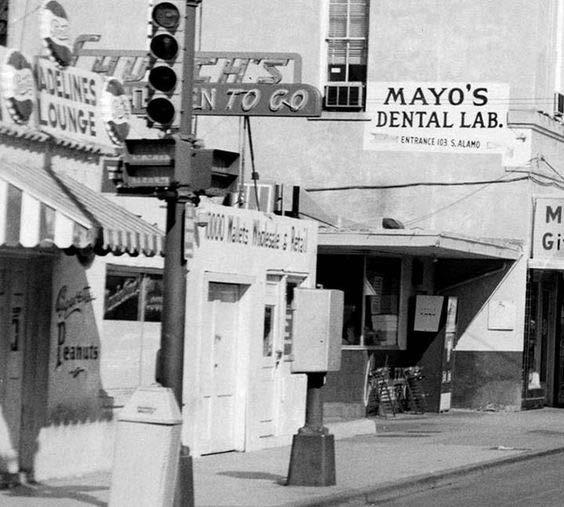
Dad parked in the Church's parking lot. I accompanied him with the Handy Andy Halloween bag. I see the manager, he is in uniform, complete with wearing his paper cap with the Church's logo. I tell Dad, "There he is!" He opens the small walk up win dow and he gives us a wave, a smile and a welcome. "Did you bring a bag Joe?" I could barely reach the window, and hand him the bag. Back then Church's was not a sit down restaurant, it was a walk up chicken to go. Church's had plenty of windows, so that
you could see the chicken being battered and fried.
He takes the bag, goes to a large refrigerator and loads up the bag with chicken and I mean he loads it, to the point of shaking the bag to fit more chicken! Through the glass window, he tilts the bag and hands it to Dad. A drumstick falls out and I catch it.
Dad tells him, "What do I owe you?" He says "Nothing, Joe." Without taking a no for an answer, Dad insists on paying him. He says "25¢". Dad reaches into his plastic coin purse and hands him a quarter. "Many thanks", says Dad and off we go.
Imagine this: Dad and I are seated in our 1956 Dodge Coronet and between us is a huge bag over flowing with Church's chicken. I am holding the bag so it doesn't tip over. Dad knows what I am thinking and he says "Go ahead" I reach for a drumstick and he does too. My very first taste of San Antonio's Church's fried chicken! Life is good!
At home, we feast on Mom's po tato salad, cream style corn, iced
tea and Church's chicken. The next day, my brother Sonny and I take plenty of Church's chicken to school for lunch. I share it with my classmates! Some had never had Church's fried chicken either.
As time goes on I find out the chicken we received was prepared on Saturday night. Saturday night was the busiest night for Church's Chicken. The chicken that they would not sell, they would refrig erate and discard it the next day. Discard it to us! The Church's location on New Braunfels St., was the third Church's Chicken and it is still there.
To this day, my chicken of choice is Church's, especially on a Sunday after Church!
Now here is a little history about Church's Fried Chicken.....
Seventy years ago, April 10,
1952, one man's dream was born. George W. Church Sr. went into the fried chicken business. It was a small little cinderblock box build ing at 111 South Alamo St.


No inside seating, all walk up. No fancy menu, just 2 pieces of chicken and a soft dinner roll in a cardboard box for 49¢. A bottle of Coca Cola vending machine was outside. Only a single ce ment picnic table for customers to enjoy their golden Church's fried chicken.
Many state that the first Church's Chicken was located across from the Alamo, well that might be true if you consider everything in San Antonio is across from the Alamo. The first Church's Chicken was on South Alamo street, 3 blocks away from the Alamo, across Com merce street, past Joske's. You
couldn't even see the Alamo from there. The location now is where the Mexican red torch thingy is. A plaque now stands across the street commemorating the birth of Church's Fried Chicken.
In the early days while KFC and other restaurant chains were concentrating on expensive high traffic areas, Church's set up res taurants in working class neigh borhoods.
Born in San Antonio, there are now over 1,700 Church's & Texas fried chicken worldwide. Church's Chicken is the world's 4th largest chicken chain.
Church's Fried Chicken, born in my beloved city of San Antonio!
Rick Melendrez, is a native San Antonian. Melendrez considers himself fortunate to have been born in San Antonio, just 3 blocks from the San Antonio de Valero mission (the Alamo) at the former Nix hospital on the riverwalk and to have attended Catholic grade school on the southside and on the riverwalk.
Catholic education is very close to his heart. Melendrez attended St. Michaels for five years (196065) and then attended St. Mary's School on the riverwalk (1965-68) and onto Cathedral high school in El Paso, Texas.
He is the former publisher of the El Paso Citizen newspaper and former chairman of the El Paso County Democratic Party. He writes a page on Facebook titled "Sister Mary Ruler, Grow ing Up Catholic In San Antonio". Everyone is invited to read about the San Antonio of the 1960's.
(Photo Captions: 3 photos are of the first Church's location in downtown San Antonio, the 4th picture is of Church's Chicken #3 on New Braunfels St.)















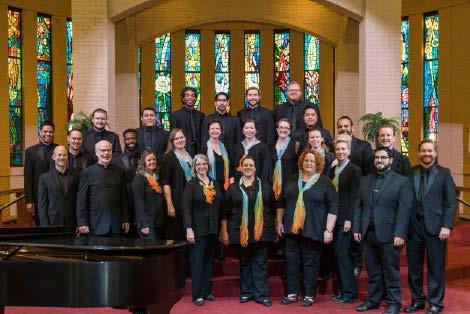
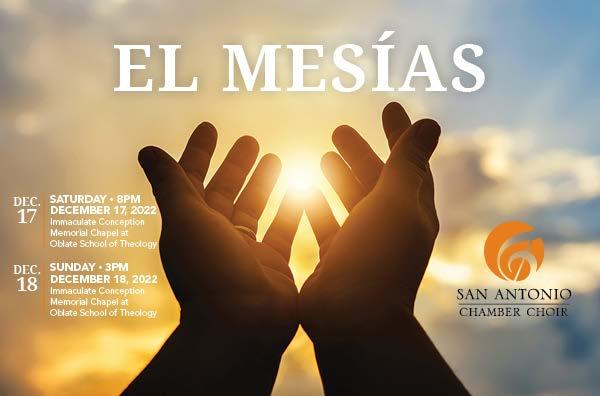 By Roland Barrera
By Roland Barrera
The San Antonio Chamber Choir is thrilled to announce their December 2022 concert series. On December 17 and 18 in collaboration with singers from the Children’s Chorus of San Antonio and local instrumentalists, SACC will present El Mesías. El Mesías is a Spanish translation of Handel’s treasured masterwork Mes siah. A musical rite for the holiday season, this will be a premiere in San Antonio of this re-imagined work. Interspersed throughout the program will include traditional Mexican carols as well as Steven Sametz’s Los Pas tores. The program will showcase the best professional singers from around the area as well as orchestral musi cians that play with leading ensembles throughout the region. Richard Bjella, SACC Artistic Director will conduct the program and soloists will be featured from the choir membership. There will be two concert opportuni ties on Saturday, December 17 at 8pm and Sunday, December 18 at 3pm. Both concerts will be presented at the Immaculate Conception Memo rial Chapel on the Oblate School of Theology campus (285 Oblate Dr, San Antonio, TX 78216). Tickets are $30 general admission and military or seniors can receive 25% off dis counts which will be honored at the door for purchase. Visit http://www. sachamberchoir.org/concert-schedule/ to securely purchase online tickets in advance to avoid lines before the performance.
Formed in 2005, SACC is a profes sional chamber choir that serves the city and surrounding areas. SACC presents regular concerts as well as community connection programs like the All-State for ALL Choir Camp and the Alamo City Street Choir. Visit www.sachamberchoir.org for more info.
